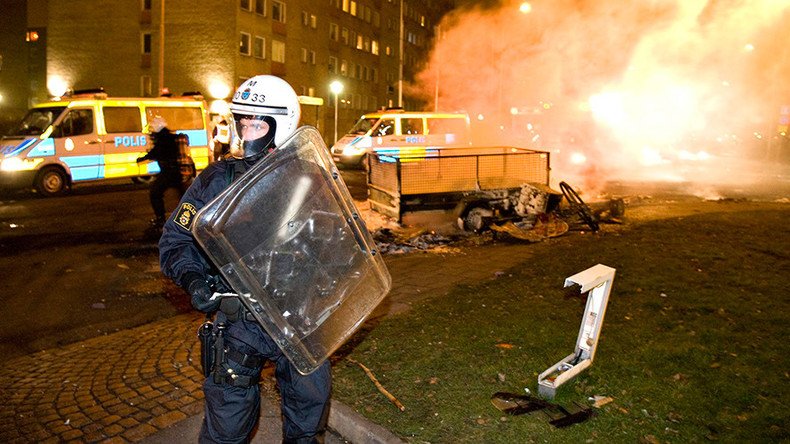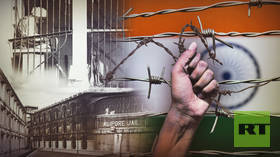No-go zones: Alt-right fantasy or new face of Europe?

Immigrant-dominated, crime-ridden and largely Muslim enclaves across Europe, the so-called “no-go zones,” have become as much an ideological battleground as a literal one, but many arguing about them have never been to one.
What no-go zones are not
For most people at most times, the designation “no-go zone” should not be taken literally.
There are exceptions. In the Stockholm suburb of Rinkeby the local police station was shut down in 2014, following the latest in a series of fire-bombing riots, and the one currently under construction is reminiscent of a war-zone outpost, to which police officers will have to be driven. Sparked by seemingly routine encounters between petty criminals and the cops, mass violent protests have originated in the district most years since 2010, though just as notably car burnings and stone-throwing flash riots are at times so frequent they are barely reported in the local media.

While Rinkeby, with its colorful moniker Little Mogadishu, and its own melting-pot dialect that has been studied by linguists, is beloved by journalists, there are other areas in Sweden, and throughout Europe, where police prefer to operate without uniforms, or do not bother to enter, unless they have a specific order, or fear violence spilling out beyond.
READ MORE: 8 more areas in Sweden added to list of so-called 'no-go zones’
Journalists are similarly made to feel unwelcome. Thousands of reports are filed from deprived neighborhoods without incident each year, and it is the exceptions that get reported, but attacks on TV crews and live report spots in particular are not infrequent.
More alarming, if harder to document day-to-day, is the hostility toward women and Jews. A petition launched by women in the Paris district of La Chapelle gathered 20,000 signatures, and was endorsed by the city’s mayor, after women complained of aggressive comments from migrants towards women dressed in Western outfits, such as “What’s up your skirt?” and “Lower your eyes, slut.”
The Jewish population of Malmo has halved in a decade, and the Simon Wiesenthal Center in Los Angeles has recommended that those who remain leave the city since 2010, with dozens of religiously-motivated street attacks recorded by the police each year. A journalist filming a documentary in the widely-covered Iraqi and Bosnian-dominated district of Rosengard while wearing a kippah was pelted with eggs and cries of “Jewish Satan!”
READ MORE: Stockholm police tighten security at anti-deportation protest after attack
But for all the lurid stories of Sharia patrols and men-only establishments, at first sight even the most notorious no-go zones are not scenes of post-apocalyptic breakdown adorned with ISIS flags, but often prosaic post-war brutalist inner-city housing blocks that have been abandoned by the native population, and have not yet been gentrified. The immediate dangers to visitors are not stray bullets or gangland enforcers, but the calorific options at plentiful local takeaways, and freely available hard drugs.
“These are not full-fledged no-go zones,”explained Daniel Pipes, the conservative writer who largely popularized the term, and went on to visit over a dozen such areas in Europe. “In normal times, they are unthreatening, routine places. But they do unpredictably erupt, with car burnings, attacks on representatives of the state (including police), and riots.”
Usually, it’s not that no one can enter a no-go zone, it’s that no one – other than the residents – wants to. And rather than the open conflict – which brings news reports and a government response – it insidious alienation and neglect that make no-go zones a blight on European societies.
Reality of no-go zones
There exists no universally accepted definition of a no-go zone, much less a comprehensive statistical analysis of them. Since 1996, France has designated over 750 Sensitive Urban Areas characterized by low house ownership, unemployment and poor educational status, and while the areas, which have a population of above 5 million people, have been used as a byword for no-go zones both inside the country and in international media, the overlap is inexact. The 61 “vulnerable areas” singled out by Swedish police are a closer match, with their emphasis on crime and resistance to state involvement, but certain social and religious factors go beyond this police definition.

Nonetheless, however they are labeled, no-go zones are “real” – insofar as that areas that have gained notoriety as such share a series of substantive characteristics and problems that are exceedingly similar around the continent.
READ MORE: ‘No-Go Zone’ app allows Parisians to report & locate aggression, other crime
Demographics
In Malmo, a city where over 40 percent of the population is of foreign origin, in areas such as Rosengard – before it was merged with another district – the number rose to 9 in 10, three out of four residents of Tottenham, where the 2011 riots started are non-White British, while the majority in Molenbeek, Brussels’ hotbed of terrorism, was also born abroad. Unlike stereotypical ghettos – a community united by a single culture or race – these areas have a diverse mix of immigrants, their make-up repeating the layers of migration into the country. In Rosengard, the former Yugoslavs were replaced by Iraqis, who are now being supplemented by Syrians, with Africans a steady but growing flow through the years. No-go zones are magnets for the least integrated and most unstable populations, who can afford to – or are assigned – to live there, traditionally with an overrepresentation of youth.
Economics
In a related point, no-go zones are some of the poorest places in their own countries, however wealthy those are. In Rosengard, four in five people are (at least officially) unemployed, in 2010 – a year before the riots – Haringey, the local authority that includes Tottenham, was the 13th most deprived out of 326 in the whole of the UK. Unemployment in Molenbeek is officially about 30 percent
Crime
Rosengard and Rinkeby are both on Sweden’s “vulnerable” list. According to the police report, 200 gangs and 5,000 criminals operate within them, but it is the fundamental disconnect between cops and residents that is the problem, and that goes beyond teens lobbing stones at police vans. “Under the surface there is a parallel society with alternative justice and with little confidence in the basic institutions of [Swedish] society,”wrote Sweden’s police chiefs in an accompanying editorial, complaining that it was “hard for police to fulfil its mission” as threats and gang presence made led to a “widespread disinclination to participate in the judicial process” among the residents. Molenbeek has been dubbed Europe’s gun marketplace, with multiple media sources reporting that a weapon could be bought within minutes in the area for several hundred euros. Notably, while dozens of terrorists were preparing the November 2015 Paris attacks, none of the neighbors or relatives of criminals reported their concerns to the police, and even after the deaths of over 130 people, no one gave up the names, as the survivors plotted another brutal attack on Brussels in the spring of 2016.
READ MORE: 4 injured in gun attack in Swedish city of Malmo, suspect at largeReligion
Partly as a function of their demographics, most of the no-go zones have a high Muslim population. Owing to alienation from mainstream society, the mosque, which already plays a bigger role in Islamic social order than churches do in modern Christianity, becomes absolutely central to the lives of locals. Whether the embrace of Islam hampers the integration of residents of no-go areas is a broader debate, but in concrete terms, these suburbs often become areas where jihadists meet like-minded associates and recruiting grounds for terrorists – many of whom fit the typical profile of young, male, immigrant residents with a criminal past. Belgium supplied more ISIS recruits than any other country in Europe per capita, many of them born or passing through the Brussels district, while Bergsjon, in Gothenburg another area on Sweden’s vulnerable list, provided 120 recruits prepared to wage jihad in Syria and Iraq.
Thus those looking to dismiss no-go areas as a “myth,” can argue the semantics of what constitutes a “no-go zone,” or how much of a threat they present, but not that term represents a real phenomenon.
Impact of no-go zones on European societies
Painting them as terrorist hatcheries is the easiest charge to pin on no-go zones. But despite Islamist terrorism’s devastating impact, the vast majority of Europeans have never been the direct victim of a terrorist attack, nor is it possible to definitively prove that it is the product of no-go zones, as opposed to say, radical Islam, mental instability, or the general effects of poverty, though it is hard to deny that places like Molenbeek provide a fertile soil for attackers.
In fact, two other – more subtle – impacts of no-go zones existence could be more debilitating.

The existence of areas of such stark cultural difference, and in the midst of some of Europe’s most prominent cities, creates alienation and resentment on both sides – from the native population that feels threatened by newcomers, to those inside the modern-day ghettoes, resentful about their lack of jobs, education in schools where no one speaks the native language, or encounters with authorities who they feel may treat them unfairly. And while incidents of poor relations between the area residents and other populations may be trivial, their effects are often cumulative, and according to several prominent studies, only better integration can lead to a restoration of social trust.
The other is the breakdown of trust in social institutions, if an area is allowed to exist outside of accepted norms. Once again, this applies not only on those who see immigrants commit crimes and don’t want to pay taxes to furnish them with benefits, but also the residents, who feel betrayed by the system.
"If people are hit by crimes which then aren't investigated, they will lose faith in the rule of law," Malmo's chief prosecutor, Ola Sjostrand, complained last year, when he noted that the entire judicial system in the city was on the verge of collapse.
“No-go areas” – whatever their exact delineation – are both the symbol and the coalface of Europe’s interaction with immigration, foreign culture, and both social cohesion and prosperity depend on reversing the worrying trends that are only likely to get worse, considering the influx of new migrants into Europe since 2015.












